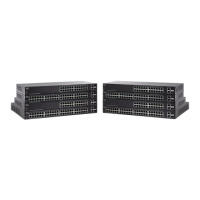Configuring Security
Configuring Port Security
Cisco 220 Series Smart Switches Administration Guide Release 1.1.0.x 206
16
STEP 3 Enter the following information:
• Interface Status—Check Lock to lock the port.
• Learning Mode—Select the type of port locking. This field is enabled only
if the Interface Status field is locked. To change the Learning Mode, the lock
interface must be cleared. After the mode is changed, the lock interface can
be reinstated. The options are:
-
Classic Lock
—Locks the interface immediately. But if the number of
addresses that have already been learned exceeds the Max No. of
Addresses Allowed, all learned addresses will be cleared.
-
Limited Dynamic Lock
—Locks the interface by deleting the current
dynamic MAC addresses associated with the interface. The interface
learns up to the maximum addresses allowed on the interface. Both re-
learning and aging of MAC addresses are enabled.
• Max No. of Addresses Allowed—Enter the maximum number of MAC
addresses that can be learned on the interface if Limited Dynamic Lock
learning mode is selected. The range is 1 to 256 and the default is 1.
• Action on Violation—If Interface Status is locked, select an action to be
applied to packets arriving on a locked interface. The options are:
-
Discard
—Discards packets from any unlearned source.
-
Forward
—Forwards packets from an unknown source without learning
the MAC address.
-
Discard and Log
—Discards packets from any unlearned source, shuts
down the interface, logs the events, and sends traps to the specified trap
receivers.
-
Shutdown
—Discards packets from any unlearned source, shuts down
the interface, logs the events, and sends traps to the specified trap
receivers. The interface remains shut down until reactivated, or until the
switch is rebooted.
• Trap Frequency—Enter the minimum time in seconds that elapses between
traps. The switch enables traps when a packet is received on a locked
interface. This is relevant for lock violations.
STEP 4 Click Apply. Port security is modified, and the Running Configuration is updated.

